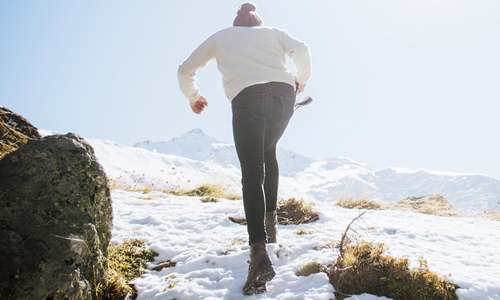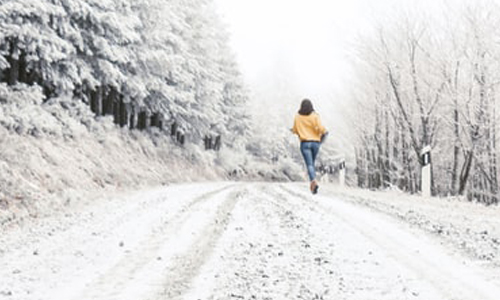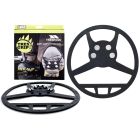Remembering Few Tips for Running on the Snowy Trail
Author

Javier Olivo is a blogger and a writer by heart. In the past, Javier worked as a woodcarver in a furniture store in his hometown. Being exposed to the outdoors, he often likes to give advice to people who prefer trekking in the woods. During his free time, Javier loves going to the gym and playing football.
Trail runners are all about dirt and they can talk about that endlessly. However, when it is winter, it is snow that creates quite a tricky situation for runners. If not being careful, snowy trails often turn dangerous with accidents and injuries that can be avoided if you know the basics.

Snow Assessment
You will be surprised to know that like trail running, snow too, has lots of types and words related to it. Knowing the snow, you are going to run on is as important as knowing the grass on the football field. Similarly, skiers also know a lot about snow, they can be dusty, dry, slushy, packed, icy, or fresh. On one side you will find the snow to be powdery and on the other hand, it can be as hard as concrete. Embrace the mentality of the skier and know the snow on the trail.
Traction and Footwear
Traction and footwear go hand in hand. In other words, the footwear you will wear on the trail depends on the snow. Snow that is soft and fresh, a trail shoe is enough to suffice. Fresh snow is known to provide better traction. On the other hand, if the snow is more into slushy or icy kind, strapping a pair of ice cleats or ice grippers is a good choice. They are good for providing extra traction when the trail is too slippery or covered by snow.
Do Not Worry About Pace
Running on a snowy trail is a bit of a challenge, no doubt. It requires a lot of effort to run on such trails. The professional snow runners also put more effort than pace when they are running on such trails. If you are doing it for the first time or have done it before, the concept is simple, you forget about how consistent you are in your pace and enjoy the new terrains. If it helps, get your music gear on the trail and use the song to maintain your moderate pace while looking at your feet to avoid tripping and falling.
Work on Your Gait
The trails you are not familiar will affect your gait and it is bound to change without you even knowing about it. When you are running on snow, showing off your technical skills is not a good idea. Instead, you should keep a low profile. Picking up your feet the usual way when you are running on the snow, leaves more room for mistakes that leads to tripping and falling.
To overcome such difficulty, maintain your feet as low to the ground as possible. This will keep injuries like, spinning, slipping, muscle straining, and splits at bay. Though, it is not as exciting as prancing around, but it is better than bailing out in the middle of the track due to some injury.

Do Not Forget About Clothing
Apart from just wearing the right shoe, and assessing the snow, you also need to layer up correctly to ensure warmth and keep frostbite at bay. Layer up is the right strategy when you are running in a frigid environment. A moisture-wicking base layer followed by a thin and breathable mid-layer and lastly, the wind and water-resistant outer layer is the right clothing idea when you are out in the sub-zero temperature.
Also, do not forget to tell your friends and family, where you are going for the run. It is important to know your whereabouts in time of emergencies.
-
 Trespass Unisex Gripping Anti-Slip Shoe Snow Ice Grippers£2.70RRP £14.99 Save Up To £12.29
Trespass Unisex Gripping Anti-Slip Shoe Snow Ice Grippers£2.70RRP £14.99 Save Up To £12.29
Author

Javier Olivo is a blogger and a writer by heart. In the past, Javier worked as a woodcarver in a furniture store in his hometown. Being exposed to the outdoors, he often likes to give advice to people who prefer trekking in the woods. During his free time, Javier loves going to the gym and playing football.
Categories
- Sport (28)
- Product Reviews (3)
- Team Outdoor Look (7)
- Mike Wild (2)
- Mike Payton (2)
- Suse Hammond-Pears (3)
- Snowboarding (12)
- Latest Offers (105)
- Shop Talk (1)
- Competitions (7)
- Walking (413)
- Lifestyle Fashion (8)
- Travel (86)
- Kit Guides (176)
- Workwear Clothing (6)
- Safety Workwear (4)
- Health/Fitness (289)
- Skiing (91)
- Great Outdoors (1316)
- Cycling (92)
- January 2025
- December 2024
- November 2024
- October 2024
- September 2024
- August 2024
- July 2024
- June 2024
- May 2024
- April 2024
- March 2024
- February 2024
- January 2024
- December 2023
- November 2023
- October 2023
- September 2023
- August 2023
- July 2023
- June 2023
- May 2023
- April 2023
- March 2023
- February 2023
- January 2023
- December 2022
- November 2022
- October 2022
- September 2022
- August 2022
- July 2022
- June 2022
- May 2022
- April 2022
- March 2022
- February 2022
- January 2022
- December 2021
- November 2021
- October 2021
- September 2021
- August 2021
- July 2021
- June 2021
- May 2021
- April 2021
- March 2021
- February 2021
- January 2021
- December 2020
- November 2020
- October 2020
- September 2020
- August 2020
- July 2020
- June 2020
- May 2020
- April 2020
- March 2020
- February 2020
- January 2020
- December 2019
- November 2019
- October 2019
- September 2019
- August 2019
- July 2019
- June 2019
- May 2019
- April 2019
- March 2019
- February 2019
- January 2019
- December 2018
- November 2018
- October 2018
- September 2018
- August 2018
- July 2018
- June 2018
- May 2018
- April 2018
- March 2018
- February 2018
- January 2018
- December 2017
- November 2017
- October 2017
- September 2017
- August 2017
- July 2017
- June 2017
- May 2017
- April 2017
- March 2017
- February 2017
- January 2017
- December 2016
- November 2016
- October 2016
- September 2016
- August 2016
- July 2016
- June 2016
- May 2016
- April 2016
- March 2016
- February 2016
- January 2016
- December 2015
- November 2015
- October 2015
- September 2015
- August 2015
- July 2015
- June 2015
- May 2015
- April 2015
- March 2015
- February 2015
- January 2015
- December 2014
- November 2014
- October 2014
- September 2014
- August 2014
- July 2014
- June 2014
- May 2014
- April 2014
- March 2014
- February 2014
- January 2014
- December 2013
- November 2013
- October 2013
- September 2013
- August 2013
- July 2013
- June 2013
- May 2013
- April 2013
- March 2013
- February 2013
- January 2013
- December 2012
- November 2012
- October 2012
- September 2012
- August 2012
- July 2012
- June 2012
- May 2012
- April 2012
- March 2012
- February 2012
- January 2012
- December 2011
- November 2011
- October 2011
- September 2011
- August 2011
- May 2010
- April 2010
- March 2010
- February 2010
- January 2010
- November 2009
- October 2009
- September 2009


Submit a Comment